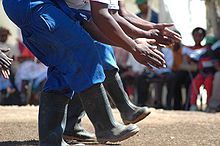Rubber boot dance
The rubber boot dance , English gumboot dance , isiZulu isicathulo , is an African dance that is often danced by dance groups in South Africa, for example in tourist centers, but also on tours by dance groups around the world.
origin
The name for the dance (isicathulo) comes from the rubber boots that are worn when dancing. The rubber boot dance probably originated in the late 19th century among workers in the Johannesburg gold mines . The rubber boots were worn there as protection against skin diseases caused by contaminated water, the workers were chained to work.
The dance
From the African heritage, the only “instruments” that the miners had left, namely their bodies and their boots, developed their own language of rhythm and music. The miners were forbidden to speak to one another. In order to be able to communicate with each other underground, the blacks developed their own musical language - similar to the "speaking drums" or Morse code - by rhythmically beating their hands on their rubber boots, stamping them and rattling chains. The dance is reminiscent of a Schuhplattler by hitting the boots . This underground form of communication slowly established itself above ground and developed into a social and cultural form of expression.
On the one hand, the dance should give the young men courage and strength. At the same time, however, they made fun of their guardians using a kind of secret language in the seemingly harmless texts, movements and dance figures. They liked to parody the movements of officers and guards without them noticing.
Some entrepreneurs allowed the best dancers, who peacefully entertained the men, to form their own dance groups. These groups sang in their native language (mostly isiZulu , Sesotho or isiXhosa ), often encoded in metaphors , about miserable lives, bad wages, bad bosses, but also about family, homesickness and love. The whites listened in amusement but did not understand the purpose of the performance. These groups were not only used to entertain their own people, but were also used as a PR measure e.g. B. used by visitors to the mines. The dance was aptly called "literature in motion". Over time, all mining companies formed their own dance troops, which competed against each other in the company's own amphitheatres. On the weekends these groups practiced their dance performances; In the process, a lot of alcohol was often consumed, which some songs that were sung with the dance tell of. The song themes are always taken from depressing life and are often onomatopoeic. In the beginning, people danced without musical instruments. When a style of its own developed in dance competitions in the first decades of the 20th century, the guitar was added. Today the accompanying ensemble often consists of guitar, accordion and violin. The ankle cuffs today are usually symbolized by a stack of rattling bottle caps on the outside of the boots.
The rubber boot dance, like traditional dances, was used early on at white folk festivals or as a tourist attraction. In the film, the rubber boot dance first appeared in Zonk in 1950 ! on.
The dance today
The rubber boot dance is performed today in South Africa, but also worldwide, as a living and independent part of South African culture. Groups of young people demonstrate it on the streets of the cities to raise some money. Today the bells tied around rubber boots are reminiscent of the ankle cuffs of black work slaves. The rubber boots - preferably underlaid with foam - can also be painted in color (e.g. zebra crossings), the groups can wear certain clothing (e.g. schoolgirl uniforms or protective helmets). In this way, the historical tradition is preserved, but in terms of themes and musical forms of expression, dance, like other folkloric forms, adapts to the modern living conditions of South Africa's youth. Comedy and slapstick elements are added.
Paul Simon recorded the title Gumboots in his Graceland album , which is held in the style of the South African Mbaqanga (Township Jive) .
A dance group under the director Zenzi Mbuli are the Rishile Gumboot Dancers of Soweto , who are known throughout South Africa, but with their show Gumboot - Rhythm is a language , developed in 1999, also performed at festivals in Europe and North America. They released a CD and a DVD (Gumboots) .
Black Umfolosi is a folk dance group from Zimbabwe , best known for their rubber boot dances.
Discography
- Gumboot guitar. Zulu street guitar music from South Africa (Music Collection of the British Library Sound Archive). Recordings by Janet Topp Fargion, Albert Nene. Topic Records, London 2003.
literature
- Carol Muller, Janet Topp Fargion: Gumboots, Bhaca Migrants, and Fred Astaire: South African Worker Dance and Musical Style. In: African Music. Vol. 7, No. 4, 1999, pp. 88-109.
Web links
Individual evidence
- ↑ a b Gumboot Dancing at southafrica.net (English), accessed on June 21, 2017
- ↑ a b c History of Rubber Boot Dance at toothillschool.co.uk, accessed June 21, 2017
- ↑ Michael J. Shapiro: Politics and time. John Wiley & Sons, Hoboken 2016, ISBN 9781509507849 . Excerpts from books.google.de
- ↑ Album review at allmusic.com (English), accessed on June 21, 2017

